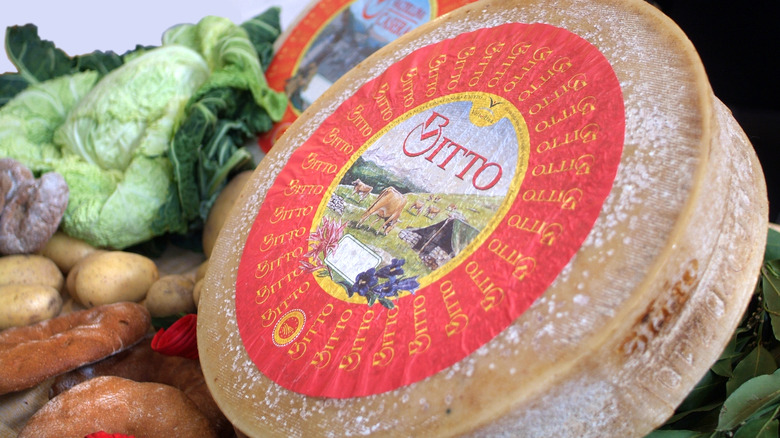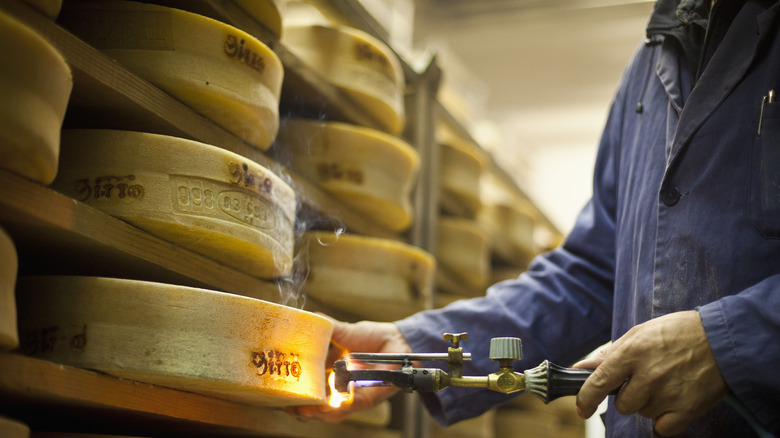This Is The Oldest Commercially-Available Cheese In The World
Since humanity discovered you could turn dairy into a flavorful solid that goes with seemingly everything (yes, you can pair fish with cheese) and keeps phenomenally well, we've been a cheese-crazy species. Cheese's ability to stay good for long periods has made the difference because not only is cheese easier to preserve than milk, but some cheeses taste significantly better when they've been left to age for longer, such as how older aged parmesan is often considered to taste better. And maybe aged cheese isn't the best idea for mac and cheese sauce, but for a cheese plate? Magnificent.
But while everybody has heard of aged parmesan or aged cheddar, they're far from the only cheeses that get left to mature gracefully. In particular, one cheese is allowed to age longer than any other commercially available variety on the market: the Italian Bitto Storico. Forget aging for a couple of years; Bitto Storico can actually be left to age for nearly a couple of decades (yes, really) — made possible due to the mixed types of milk (cow and goat) used in its production, as well as its very specific cheesemaking process.
Bitto Storico only comes from one Italian province
You won't find Bitto Storico on random grocery store shelves because it's one of the rarest cheeses in the world. Only one region produces it: The Sondrio province in the Valtellina Valley in Lombardy, where it's named after the Bitto River. There are actually only 12 producers of it in the world, and though their specific processes vary, what's common to all Bitto Storico is that the cow's milk that makes up the majority of its content is processed twice – once in the morning and once in the evening — right after the cows get milked. It's also only produced for four months of the year, throughout the whole of June until the very end of September.
Not every wheel of Bitto Storico will be 20 years old, and in fact, most probably won't be. Typically, the Bitto Storico you can find from cheesemongers is around five to 10 years of age. It can go longer, though, depending on its milk composition. While cow's milk forms the majority of Bitto Storico's base, milk from Orobica goats (a species native to the region) is also part of the process. The more goat's milk used in its production, the longer it will typically last (though goat's milk can never make up more than 10% of its base). Both the cows and goats whose dairy is used for Bitto Storico are also exclusively free-range.
Bitto Storico isn't cheap, but it's definitely tasty
As you might expect, Bitto Storico isn't cheap: a 15-year-old wheel once sold for $6,400 in China. Younger varieties (Bitto Storico must be aged for a minimum of 70 days) are somewhat cheaper, but this still isn't like a block of sharp cheddar. Some vendors sell 500 grams (a little over a pound) for around $20. Other retailers are more expensive, however, with 300 grams (⅔ of a pound) selling for around $25.
The taste, meanwhile, changes depending on how long the cheese is aged. It's a semi-hard cheese with a fatty quality but tends to be softer and sweeter at younger ages. Older varieties are not just more solid but also wind up somewhat more bitter and spicy. Though it's not as potent as the overpowering funk of a smelly cheese like Limburger, Bitto Storico certainly has a distinct odor, described as a mix of hay, meat stock, and melted butter.
If you're ever in the Valtellina Valley, be sure to give Bitto Storico a try if you have the opportunity. After all, there's nothing like experiencing unusual things, and 15-year-old cheese certainly qualifies.


